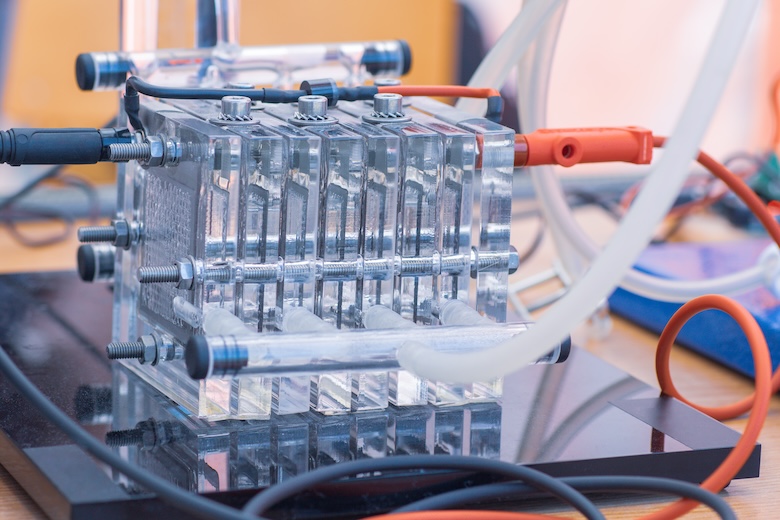As the world transitions towards a net zero future, hydrogen is growing in importance as one of the key elements that will help deliver a more sustainable future. Used as both storing energy and as fuel, hydrogen is potentially transformative in the battle to reduce emissions, with reports predicting over 9 trillion USD in investment1 pouring into hydrogen, making the industry bigger than the oil and gas sector and automobile market combined.

Electrolysis which is a chemical process that separates hydrogen and oxygen molecules of water using electricity. Hydrogen produced by electrolysis can result in zero greenhouse gas emissions, depending on the source of the electricity used.
The current and future market needs for hydrogen sealing, storage, transportation, generation, and end use are very broad — ranging from standard components to highly engineered solutions where few in the industry have extensive experience. John Mclaughlin, Trelleborg’s Director of Research and Development Services in the U.S., discusses the pain points for hydrogen sealing and what kind of testing capabilities are needed to help original equipment manufacturers navigate this evolving market.
Q: What’s the big deal about hydrogen?
A: In the future, hydrogen could play a significant role in making transport more sustainable and most importantly support the stabilization of the electricity grid.
Hydrogen is traditionally used to produce methanol and refine petroleum. The world is looking to more sustainable energy production and ways to reach net zero emissions by the year 20502, and using hydrogen as fuel for applications like trucks, buses, and cars is an increasing topic of conversation. In addition, carbon-neutral green hydrogen can be created through the electrolysis of water powered by renewable sources like wind and solar. This means the hydrogen can essentially act like a battery, storing energy that would otherwise be lost when renewable generation exceeds what electricity grids can deploy. However, using green hydrogen comes with challenges, including how to store and transport it and how to test and validate hydrogen sealing where no standards exist.
Q: Why are there currently no testing standards for validation?
A: The new and evolving nature of the hydrogen market and value chain creates a demand for fuel and storage standards. Experts are looking to existing standards for similar storage applications like those for oil and gas. These standards define acceptable characteristics for polymers in arduous conditions; however, no existing standards provide a perfect fit because of hydrogen’s inherent characteristics.
Hydrogen is an explosive gas, and it must be tested with great care. Many seal manufacturers therefore use third-party testing facilities. Trelleborg instead is setting its own test standards and investing in comprehensive capabilities and facilities that will meet application-specific hydrogen requirements and help customers with speed to market.
Q: What kind of challenges exist related to hydrogen sealing and storage?
A: Hydrogen is difficult to seal because it is the smallest of all molecules. In gaseous form it can permeate into a seal, so sealing materials must demonstrate high resistance to permeation.
A second related issue is rapid gas decompression (RGD). In a high-pressure system, small hydrogen molecules can be absorbed into a seal. If the pressure in the system is suddenly relieved, gas trapped in the seal can expand to match the new ambient pressure, potentially causing the seal to blister and crack as the gas tries to escape.
Finally seals for different hydrogen systems need to withstand seriously tough environments, including high pressures of up to 15,000 psi (1,000 bar) — for example, in high-pressure valves — and extreme low temperatures down to -418° F (-250° C) — for example, in liquid hydrogen storage and transportation.
Q: What kind of testing capabilities exist that OEMs should explore for hydrogen storage and transport?
A: Trelleborg has advanced testing capabilities that produce data on permeation and leakage using helium as a proxy. Seals are tested to ISO 15848 conditions using full vacuum data collection at temperatures from -40° F to 351° F (-40° C to 177° C) and pressures from 10,008 psi (690 bar) to 21,756 psi (1,500 bar). We conduct additional tests to ISO 15848 primarily for valve sealing and polytetrafluoroethylene (PTFE) stacks.
Other tests include ISO 17268 for hydrogen RGD, EC79 for hydrogen-powered motor vehicles, and SAE J2600 for compressed hydrogen surface vehicle fueling connections. Existing test data covers materials including ethylene propylene diene rubber (EPDM), fluorocarbon rubber (FKM), and polyurethanes, notably our proprietary Zurcon material.
We also have testing capabilities related to counter surface baseline specification, dynamic sealing, compatibility and thermal cycling at various pressures.
Trelleborg
trelleborg.com
Sources:
- https://www.bqprime.com/business/global-green-hydrogen-supply-needs-94-trillion-investment-by-2050-deloitte
- https://www.iea.org/reports/global-energy-and-climate-model/net-zero-emissions-by-2050-scenario-nze
Filed Under: NEWS • PROFILES • EDITORIALS, Seals • O rings, Seals




